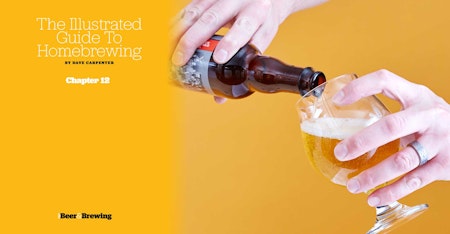Hops are a vital ingredient in most beers, but they can present a messy problem. We need them in the boil but really don’t want them in the fermentor. Whole-leaf hops become bulky as they absorb wort and break apart, while pellet hops turn into green sludge. Either way, they can easily clog a valve, a racking tube, a pump, or a counterflow chiller.
There are several standard ways to solve this problem. The most traditional is to whirlpool the wort at the end of the boil. This collects the hops and trub in the center of the kettle, keeping them away from the drain or racking tube. The downside is that the whirlpool needs time to work; otherwise, it leaves a fair amount of hops in the solution (especially with pellet hops). Also, super hoppy beers can overwhelm this technique.
Alternatively, you can use a filter, either on your racking tube or attached to the kettle drain. There are numerous commercial choices, such as the Bazooka Screen or the Hop Stopper, but you can also make a simple filter out of a copper scrubber. Any of these work reasonably well, although pellet hops can often clog them up. Cleaning the filter afterward is also a hassle.
Another option is to use muslin or nylon bags to hold your hops during the boil. This keeps them contained, but there’s a trade-off. Your hops utilization will be lower because the hops are crammed together, rather than free floating. Generally, you’ll need a separate bag for each addition, and you must avoid over-packing them. Big, hoppy beers may require quite a few bags to handle all the hops.
Cool Alternative: A Hop Spider
A fairly simple solution is the hop spider, which comes in a couple of different styles. One is a metal mesh cylinder that hangs inside the kettle during the boil. The other is a metal frame with a large nylon bag attached, which perches over the kettle. During the course of the boil, hops are added to the cylinder or bag. Hops utilization is still a minor issue, but the larger size gives the hops more room to infuse the wort.
The nylon bag version is a great DIY project because it’s trivial to build and the parts are quite inexpensive.
Parts
- One 4" x 3" (8 cm x 10 cm) ABS reducing coupler
- Three long 3/8" (10 mm) eye-bolts to form the spider’s legs. The length should be equal to the radius of your kettle or a little longer.
- Six steel washers (3/8"/10 mm hole)
- Six 3/8" (10 mm) nuts
- Large (3"/8 cm or larger) hose clamp
- 5 gal (19 l) nylon paint strainer bag
Tools
- Drill
- Hammer and vice
- Pliers
- Screwdriver
Build Steps
- Drill 3 equally spaced 3/8" (10 mm) holes in the middle of the fatter side of the coupler (see below).

- Warp 3 of the washers so they’ll fit the inside edge of the coupler. To do this, I placed a washer across a ½" (1 cm) gap on my vice, laid an eye-bolt on top, then gave it a whack with a hammer to bend the washer slightly.
- For each leg of the spider:
- Thread a nut onto an eye-bolt so it’s a couple of inches (about 7 cm) down.
- Put a flat washer on the bolt.
- Slide the eye-bolt through one of the holes in the coupler.
- Put a curved washer on the bolt so it snugs up against the inside edge of the coupler.
- Thread a second nut onto the bolt just far enough for the bolt to protrude slightly past the nut.
- Holding the bolt in place, tighten the nut on the outside of the coupler until it snugs together tightly (see below).

- Feed the neck of the paint strainer bag through the coupler from the wider side, then wrap it back over the narrower opening.
- Use the hose clamp to hold the bag in place (see below).

Usage
On brew day, once you’re ready to start the boil, place the hop spider across the top of your kettle, with the bag hanging down inside the kettle. Then, for each hops addition, just pour the hops into the mouth of the hop spider. At the end of the boil, you can drain the kettle like normal, but all the hops will stay inside the strainer bag.
When it’s time to clean up, loosen the hose clamp and detach the bag. Empty out the spent hops, and then turn the bag inside out to rinse off all of the hops particles. Hang the bag up to dry. Once it’s dry, you can brush away any remaining hops particles.








